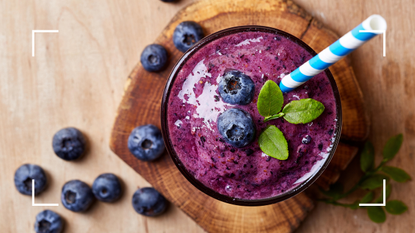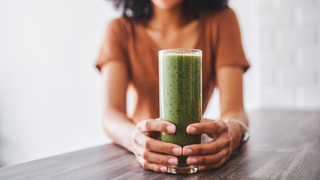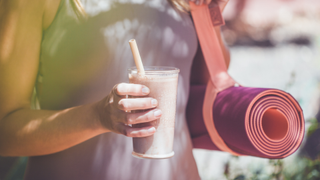What is the smoothie diet? Blend up these foods to give your body a nutritious boost
If you want to give the smoothie diet a go, sip on these nourishing recipes...

You may have heard that the smoothie diet is a great weight to begin a health kick—but there are a few things you should know first. Before trying a new weight loss plan, it's important to remember that healthy, sustainable weight loss is a combination of a consistently nutritious diet and regular exercise. What's more, sipping on blended-up goodness should never be adopted as a long-term way to fuel yourself, and what you add to your shake is key to ensuring your body gets exactly what it needs.
If you're wondering how to lose a stone in a month and believe the smoothie diet can help you achieve that goal, then we're here to explain what it is, which foods to add to your blender, how long you should do it for and what to beware. It's crucial to never starve yourself, because not only is this potentially dangerous, but it can also sabotage weight loss by causing you to lose muscle which will, in turn, slow down your metabolism. It is vital before embarking on a restrictive diet like this to consult your doctor, and it may be that long-term eating regimes like the science-backed Mediterranean diet are more suitable for you.
What is the smoothie diet?

The smoothie diet is a one-day plan, devised by dietitian Nigel Denby. It is intended to provide your body with all the nutrients it needs over a 24-hour window—so that you remain properly fuelled and don't lose any muscle—before solid foods are then reintroduced. It is claimed that this can help you lose 1-2lbs per week as part of a nourishing diet and regular fitness across the other six days. Indeed, if healthy, sustainable weight loss is your goal, then it is also important to factor in exercise like strength training, which increases muscle mass, boosting your metabolism and therefore increasing calorie burn.
However, it is important to note that replacing solid meals with smoothies should only ever be done for a very short period of time. While the NHS's Eat Well guide recommends a third of your diet should consist of fruit and vegetables, they suggest you should limit yourself to a 150ml smoothie a day, to cap your intake of "free sugars" which are released during the blending process. Additionally, a lack of solids could also significantly reduce your fiber intake—government guidelines advises that you should consume 30g a day in order to lower the risk of heart disease, stroke, type 2 diabetes and bowel cancer.
Here's what else you need to know:
- Decide which day you're going to use as your shake day and buy all the ingredients you need.
- Don't be tempted to skip any of your shakes—starving yourself is definitely counter-productive to healthy, sustainable weight loss.
- On your shake day, just have your three shakes and two liters of water—no tea, coffee, alcohol or snacks.
- Don't kid yourself you can eat whatever you want all week and then use the one-day smoothie diet to put everything right. You need to eat well the other six days a week too. Additionally, don't be tempted to drink exclusively smoothies for more than the one day.
- Don't cut corners by buying ready-made smoothies—when considering, are smoothies good for you, it's always best to opt for homemade versions. Shop-bought options are often full of sugar, and might not contain all the nutrients you need.
Smoothie diet recipes to try

Choose three shakes from the below options for the day, add all the ingredients into a blender and blitz for 30 seconds until smooth.
Green extreme—200g low-fat Greek yogurt, a handful of ice cubes, ½ cucumber, 1 carrot, sliced 1 kiwi peeled and 2 handfuls of washed baby spinach
Sign up for the woman&home newsletter
Sign up to our free daily email for the latest royal and entertainment news, interesting opinion, expert advice on styling and beauty trends, and no-nonsense guides to the health and wellness questions you want answered.
Breakfast booster—30g protein powder, 1 banana, a handful of sultanas, a handful of almonds, a handful of porridge oats and 200ml skimmed milk
Mediterranean magic—30g protein powder, ½ avocado, 2 large tomatoes, 1 red pepper, plus a handful of fresh basil and a handful of ice cubes
Blue velvet—200g low-fat Greek yogurt, 2 handfuls of blueberries, 2 stoned plums, 1 banana, a handful of spinach and a handful of ice cubes
Summer cooler—½ cucumber, 1 stick of celery, ½ avocado, 30g protein powder, handful of fresh parsley and a handful of ice cubes
Berry bliss—1 kiwi peeled, 200g low-fat Greek yogurt, 2 handfuls of strawberries hulled, 2 handfuls of raspberries, handful of porridge oats and ice cubes
What to eat the rest of the week
- At least 5 servings of veg—leaves, tomatoes, beans, cabbages. Avoid potatoes and starchy veg.
- 3 servings of fruit.
- 2 servings of whole grains—for example, 1 thin slice of wholemeal bread, 2 Ryvita, 4tbsp porridge oats, 2tbsp wholegrain pasta or brown rice, or 2 oatcakes. For more complex carb inspiration, sample some ancient grains.
- 2 servings of 200ml semi-skimmed milk, a non-dairy alternative or low-fat yogurt, 150g hard cheese or 200g cottage cheese.
- 2 servings of 150g chicken (skinless), 200g fish or shellfish, 1 egg, 200g beans or pulses, 50g unsalted nuts, or 150g lean red meat (no more than twice a week). If you're trying to eat more plant-based, there are many sources of vegan protein you can try.
- Adopt mindful drinking—have no more than 200ml wine, ½pt beer or one measure of spirits per day, and always have two alcohol-free days per week.
Amy Hunt is an experienced digital journalist specialising in homes, interiors and hobbies. She began her career working as the features assistant at woman&home magazine, before moving over to the digital side of the brand where she eventually became the Lifestyle Editor up until January 2022. Amy won the Digital Journalist of the Year award at the AOP Awards in 2019 for her work on womanandhome.com.
-
 Keira Knightley styles the best chocolate brown blazer with a blush pink skirt, coffee tone jumper and white slingback heels
Keira Knightley styles the best chocolate brown blazer with a blush pink skirt, coffee tone jumper and white slingback heelsAn oversized blazer is the answer to our cold-weather styling dilemmas
By Molly Smith Published
-
 Shetland season 9 ending explained: Who murdered Annie and Bergen?
Shetland season 9 ending explained: Who murdered Annie and Bergen?We delve in the Shetland season 9 final episode to unpick everything happened, and find out who was responsible for the death of Annie and Bergen.
By Lucy Wigley Published
